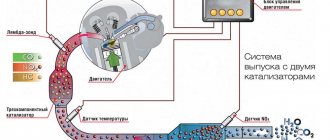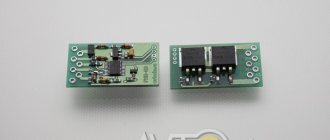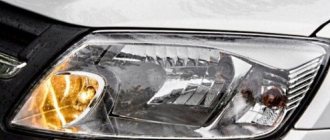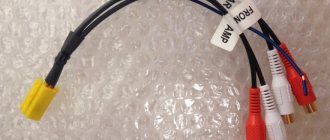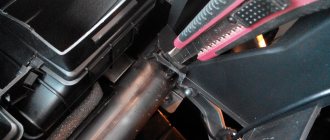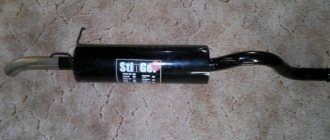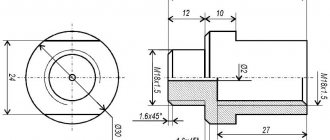An engine element such as spider 2114 is a type of exhaust manifold that provides the most optimal operating modes of the power plant.
Many motorists are thinking about replacing this part, because the original manifold on the VAZ 2114 is designed for operating modes in accordance with Euro-3 requirements, due to which the car loses more than 10 hp in power.
By simply replacing the base manifold with a spider, this situation can be easily corrected. We'll talk about how the spider itself works and how to install it below.
Spider on VAZ 2114
How to make a replacement
The entire replacement of the VAZ 2114 spider takes place in several stages:
- Place the car on an overpass or pit, put the handbrake on and secure the wheels with stops (shoes).
- If the car has been running recently, let it cool down.
- Remove the crankcase protection.
- Unscrew the bolts securing the exhaust manifold pants to the catalyst inlet (to make unscrewing easier, they should be treated with WD-40 lubricant before starting work).
- If the replacement is partial, then leave the catalyst and muffler in place; if it is complete, then remove it.
- Unscrew the nuts securing the manifold to the cylinder head.
- Dismantle the “original” manifold and the gasket located under it.
- Install the spider instead of the standard manifold (if the spider matches the model, then it will definitely fit into its place). Before installation, you should place a new gasket under it.
- If the old fasteners are severely corroded, then new ones should be installed instead, preferably coated with copper or brass.
- If a partial replacement is performed, then you need to check the alignment of the spider pipe with the catalyst inlet. As a rule, the exhaust pipe of the spider is longer, so you will have to cut off and dismantle not only the catalyst, but also part of the exhaust pipe, instead of which a resonator should be welded.
- Connect the spider's output pipe to the resonator.
- If a complete replacement occurs, then the same operations are performed as in the previous paragraphs, but instead of the entire “original” exhaust system, a direct-flow exhaust system is installed.
After installing the spider, you will also have to replace the lambda probe (with a new one, with an extended wire). The completion of the entire modernization process will be the flashing of the ECU, which should be performed at a car service center. It will help register the new system in the computer as “standard”, and will also show the increase in power obtained as a result of the upgrade.
Replacing the Catalyst for Spider VAZ 2114
Installing a flame arrester instead of a catalyst
But high-class auto repair shops have figured out how to deceive the engine ECU - we will reflash the engine ECU, excluding the second lambda probe from the circuit. The electronics “believes” that there is no second detector in the exhaust system, so it does not expect any readings from it, and the engine operates as usual. With the “bleeder” (installed after removing the catalyst), the consumption of the fuel mixture remains the same as before with the catalytic converter.
If the catalyst is excluded from the gas exhaust system on a gasoline engine, the combustion products of the fuel mixture will act as an unextinguished flame and lead to failure of parts of the gas exhaust system (resonator, muffler). To increase the service life of the gas exhaust system, it is necessary to install a flame arrester in it. If there is such a possibility, then you can replace the catalyst with a flame arrester in the same place. If the catalyst is simply thrown out of the system, the engine ECU will display the error “insufficient catalyst efficiency p0420”. To prevent this from happening, either a decoy is installed, or the engine ECU is fully re-flashed to operate within Euro2. The more modern and complex the car, the more complex the methods for testing and monitoring the efficiency of the catalyst, so the use of decoys in terms of the significance of the result comes to naught. For example, as catalyst performance decreases, the engine ECU can change the mixture composition to reduce catalyst wear.
When removing a particulate filter on a diesel engine, you must programmatically disable the use of the particulate filter in the engine ECU - make changes to the firmware. This allows you to further significantly improve the dynamic performance of the engine. The presence in the service station of specialists with the necessary qualifications, modern equipment, as well as firmware from global manufacturers of various car brands with the necessary modifications allow us to fully remove the particulate filter on almost any diesel engine.
Manifold dismantling procedure - step-by-step instructions
The dismantling process itself is not so complicated; access to some nuts is difficult, so it is advisable to carry out the work on a lift or in an inspection pit. The algorithm of actions for the injection VAZ-2114 in this case looks like this:
- Remove the negative terminal from the battery or turn off the mains switch.
Remove the terminal from the battery
Drain the coolant from the system
Removing the fuel pipes
Search under the hood chapter 1. network spider
Disabling the throttle position sensor
Disconnect the muffler exhaust pipe from the manifold
- Which spider insert to choose instead of a catalyst from 2022
Dismantling the exhaust manifold mountings
Removing the exhaust manifold
Replacement of gaskets and installation of manifold
After dismantling the manifold, it is rarely possible to remove the gasket intact. It changes in any case, but parts of the destroyed gasket will definitely remain on the mating plane on the head side and on the manifold side. They must be carefully removed.
Changing the manifold gasket
Also, when installing new exhaust manifold gaskets, it is not recommended to use sealants. They can be of different quality, and during crimping they can form particles that get into the crankcase, which is extremely undesirable.
Selecting the appropriate modification
Part installed on the machine
When choosing a “spider” for a Priora, two options are most often considered - 4-1 or modification 4-2-1. It all depends on what final result we want to get. The 4-1 manifold produces an optimal increase in power in a fairly narrow rpm range. It has four pipes from the valves connected into one without transitions. Collectors are available with both short and long pipes. Modification 4-1 is suitable for engines with high afterburner, speed range from 6 to 10 thousand per minute. Typically, these “spiders” are installed on engines with camshafts with a phase of more than 285 degrees.
Exhaust manifold for VAZ 2114
Spider 4-2-1 is a part in which four pipes from the cylinders are connected first in pairs, and then into one common pipe. It gives a less significant increase, but over a wider rpm range. These parts are installed on medium-boosted engines. It is believed that short versions of the 4-2-1 model are effective at revolutions above 4500 per minute, and long ones at average speeds from two and a half to four thousand per minute.
The 2-2 “spider” configuration, when four pipes turn into two in pairs, each of which has a separate outlet, (you get two outputs) is practically not found in mass production. However, amateur welders perform modifications for themselves, as shown in the photo. Such work was carried out by autogen and camping, for which pipe blanks were cut and adjusted using angles. Some believe that this 2-2 “spider” configuration does not provide the ability to connect a lambda, so its use is not always justified.
There is no single scheme for selecting a 2-1 spider or another for a Priora car, since the choice of modification is made mainly during testing on a bench. But there is a formula for the length of the primary pipe (the distance from the valve to the end of the primary pipe) which is the following:
L = A x C x DxD / 1400 (constant) x BxB, where
Variable
Meaning
VAZ, remove the catalyst, install spider 4-1, high consumption, cleaning the air flow sensor, oil in the air duct
The resulting length must be multiplied by integers. The total length of the pipes from the connection to the valve on the Priora is approximately (!) determined by the formula (regardless of the 2-1/4-1 modification):
M = 2159 x (K+180)/T - P, where
K is the opening size of the exhaust channel in degrees before BDC, along the crankshaft;
T is the required engine speed for which the car is tuned;
P is the length of the outlet channel.
After the car owner has decided on the required “spider” model, he needs to purchase a muffler, a resonator (direct-flow, sports), a graphite ring and an oxygen sensor adjusted to the length to carry out the work. Models 4-2-1, offered in stores for the Priora car, have a nut for the oxygen sensor, so installing it will be quite easy. If the spider does not have a built-in sensor, then after installing it you will need to replace the firmware on the ECU.
Some features
VAZ, remove the catalyst, install spider 4-1, high consumption, cleaning the air flow sensor, oil in the air duct.
There are several nuances that should be taken into account when remaking the exhaust system of the VAZ-2114. The installed tuning manifold is wider in size, so it will touch the rubber pipe leading to the stove. To prevent this from leading to coolant leakage in the future, this pipe should be replaced with a new, longer one, and taken away from the manifold.
The lambda probe will also have to be replaced, since the hole for its mounting in the tuning manifold is lower than in the standard one, which is why this sensor with extended wiring is needed.
Also, the “Spider” is more voluminous at the bottom, so installing underbody protection is no longer possible.
The final stage of all this work is reflashing the electronic control unit, which will allow the new exhaust system to be “perceived” as standard. Also, flashing will allow you to “unleash” the full potential of the power plant after processing. It is better to perform flashing from knowledgeable specialists at a service station.
This is all the work related to the processing of the exhaust system of the VAZ-2114 car.
Replacement on a 16-valve engine
In the case of a 16-valve power unit, the catalyst is included in the design with the output manifold. Therefore, look for it behind the cylinder block directly in the engine compartment.
The nuance of dismantling the 16-valve engine is the presence of two lambdas.
- The first is located directly on the catalyst. It serves to adjust the fuel mixture;
- The second is located on the flange after the device. It is called ecological. If this lambda is not in place, the sensor will immediately generate an error, the injection will stop working properly, thrust will increase and fuel consumption will increase.
There are two ways to solve this issue:
- If you bought a spider for one regulator, the electronic control unit can be upgraded to Euro 2 from the current Euro 3. But such a spider has a serious drawback - the only thread for the lambda is on the flange. To mount the injection lambda there, you will have to assemble an extension cord from a wire and two connectors, called mother-father.
- If it is a spider with two regulators, the injection lambda is mounted in a standard socket. The thread for the second sensor is plugged or a dummy for the electronic control unit is installed in its place. In the second situation, there is no need to reflash the ECU.
What is needed for replacement
In order to install the spider on a VAZ 2114, you will need a minimum set of tools and accessories, namely:
- set of keys;
- angle grinder (grinder) - in some cases;
- cutting discs for angle grinders;
- welding machine - in some cases;
- WD-40 composition;
- new fasteners for the exhaust system;
- new lambda probe (equipped with an extended wire).
In addition, when installing the spider, you should also replace the exhaust manifold gasket.
Exhaust system "Stinger"
As for choosing a spider manufacturer, you should give preference to the Stinger company, since its products are of high quality and have long been popular among motorists. In addition, you can purchase parts from other companies, but preference should be given to the middle or high price range. You should not purchase cheap spiders, as low-quality products can quickly fail.
What is needed to carry out the work?
You can carry out all the work yourself, having previously purchased everything you need. The alteration of the exhaust system can be partial, with the replacement of the catalyst with a resonator, but in this case, the “Spider” will not fully ensure its effectiveness, and a complete replacement of the exhaust system.
First of all, you need to buy the “Spider” itself for the VAZ-2114 car; it is better to take the 4-2-1 type. If the processing is complete, you will also need a resonator and a direct-flow muffler, and if it is incomplete, only a resonator. When replacing, the exhaust manifold gasket must be changed. You should only buy parts from reputable companies. Such a manufacturer is, for example, Stinger, but there are others.
Tools you will need:
- A set of keys;
- Welding machine (possibly);
- Grinding machine with cutting wheel (possibly);
- New exhaust system fasteners;
- Lambda probe with extended wiring;
- WD-40;
Sequence of work
With all this at hand, you can get to work:
We install the VAZ-2114 on the inspection hole and immobilize it. If the car is just from a trip, give the exhaust system time to cool. Remove the crankcase protection. We unscrew the bolts securing the exhaust manifold pants from the exhaust pipe of the catalyst and disconnect them. It is better to pre-treat the fastening bolts with WD-40. If the replacement is only partial, leave the catalyst and muffler in place for now. But with a complete replacement, we remove everything that comes from the collector’s pants from the VAZ-2114. Let's move on to the engine compartment. We unscrew the nuts securing the exhaust manifold to the block head, having previously treated them with WD-40. Carefully remove the standard manifold and the gasket located under it. Next, the Spider is installed. If the choice is made correctly, it will fall into place without any problems.
It is important not to forget to install a new gasket under it. If the old fastening nuts are heavily rusted, it is better to replace them with new ones, copper-plated or brass. Let's go under the car
In case of partial replacement, we try on the coincidence of the “Spider” with the exhaust pipe of the catalyst. Usually the “spider” is longer than the standard manifold, so the exhaust system will have to be shortened, which is why a grind is needed. machine (grinder) and welding machine. Then the catalyst is completely cut out. Along with the catalyst, it may be necessary to remove part of the pipe that goes behind it. And in its place a resonator is welded in, everything is first adjusted to the length. We connect the “Spider” to the receiving pipe of the resonator. This completes the partial replacement. For a complete replacement, we do the same as for a partial replacement, but with a new direct-flow system and resonator. That is, we hang a new exhaust system with a resonator on the car, take measurements, adjust it to length if necessary, connect and secure everything.
Replacing a device on an 8-valve engine
Inexpensive repairs
On a VAZ 2114 engine with eight valves, the catalyst is located behind the exhaust manifold, but in front of the resonator directly on the bottom of the car. Many car enthusiasts neglect to replace this device, mistakenly believing that it has no effect on environmental pollution and does not interfere with the normal operation of the engine. But, alas, this is not so. Many even manage to install an ordinary corrugated pipe instead of a catalyst, which significantly increases the noise inside the car and, most importantly, leads to the rapid destruction of the muffler itself. In order to carry out inexpensive repairs to the device, you need to cut out a small area in it and knock out the ceramic honeycombs from it. Then weld, thereby sealing the body. But with such repairs, you need to be prepared for the fact that noise in the car interior will accompany you everywhere. The best option is to replace the factory catalyst with an effectively working flame arrester.
Open heating system: operating principle
The main feature of an open heating system, in addition to the absence of a circulation pump, is the presence of a leaky expansion tank, also called a damper. It is necessary to compensate for the increase in coolant volume when heated. The hot water leaving the boiler is directed upward, creating an area of reduced pressure at the boiler inlet.
In an open heating system, water always acts as the coolant, since other substances evaporate very quickly through the expansion tank.
The amount of water in the system must be replenished from time to time, since its lack can lead to the formation of air pockets that prevent the circulation of the coolant and reduce the efficiency of heating the premises. It is enough to check the water level in the system only a couple of times during the heating season, which is not a big problem. To eliminate air pockets, special taps are integrated into the system through which air can be released.
Open heating system: 1 - boiler 2 - cold water 3 - boiler 4 - expansion tank
An open heating system consists of the following components:
| Hot water boiler . It can run on a variety of fuels: natural or liquefied gas or electricity. Liquid or solid fuel models are extremely rare, as they require a separate room for storing energy reserves. |
| Heating radiators . They can be made of aluminum or cast iron. Steel radiators are susceptible to the influence of oxygen, which is necessarily present in the coolant, so it is not recommended to use them in an open heating system. But you can use bimetallic batteries. Sometimes a thick steel pipe with a diameter of at least 10 centimeters is used as a radiator, which encircles the entire house along the perimeter. |
| Pipeline . To ensure unimpeded circulation of the coolant in the system, it is necessary to choose pipes of large diameter, from 2.5 to 5 cm. They can be made of polyethylene or polypropylene with fiberglass piping. In this case, at the outlet of the boiler the diameter of the pipes should be maximum, and at the inlet - minimum; it is due to the difference in diameters that the necessary pressure drop is created. |
| Expansion tank . Dampers are usually made of stainless steel. They are located at the highest point of the system, on the return pipe or on the attic floor or in the attic, if it is possible to maintain a constant positive temperature of the coolant there. The minimum installation height of the damper is 2.7 meters. Its design provides several pipes: expansion, overflow, control. |
When installing an open-type heating system, it is necessary to observe the required pipe slope: at least 5 mm for each linear meter. The pipeline diagram is conventionally divided into two parts: supply, through which hot water moves from the boiler to the radiators, and return, through which cooled water returns from the radiators to the boiler.
How to make a replacement
The entire replacement of the VAZ 2114 spider takes place in several stages:
- Place the car on an overpass or pit, put the handbrake on and secure the wheels with stops (shoes).
- If the car has been running recently, let it cool down.
- Remove the crankcase protection.
- Unscrew the bolts securing the exhaust manifold pants to the catalyst inlet (to make unscrewing easier, they should be treated with WD-40 lubricant before starting work).
- If the replacement is partial, then leave the catalyst and muffler in place; if it is complete, then remove it.
- Unscrew the nuts securing the manifold to the cylinder head.
- Dismantle the “original” manifold and the gasket located under it.
- Install the spider instead of the standard manifold (if the spider matches the model, then it will definitely fit into its place). Before installation, you should place a new gasket under it.
- If the old fasteners are severely corroded, then new ones should be installed instead, preferably coated with copper or brass.
- If a partial replacement is performed, then you need to check the alignment of the spider pipe with the catalyst inlet. As a rule, the exhaust pipe of the spider is longer, so you will have to cut off and dismantle not only the catalyst, but also part of the exhaust pipe, instead of which a resonator should be welded.
- Connect the spider's output pipe to the resonator.
- If a complete replacement occurs, then the same operations are performed as in the previous paragraphs, but instead of the entire “original” exhaust system, a direct-flow exhaust system is installed.
Installed spider on a VAZ 2114
After installing the spider, the lambda probe will also have to be replaced (with a new one, with an extended wire). The completion of the entire modernization process will be the flashing of the ECU, which should be performed at a car service center. It will help register the new system in the computer as “standard”, and will also show the increase in power obtained as a result of the upgrade.
Popular myths
Varieties
Some people deliberately get rid of the catalyst, others deliberately ignore the clogged unit. All this caused the spread of myths.
- By removing it, the engine gains power. A misconception that arose for unknown reasons.
- The engine cannot “breathe” normally due to the catalyst. Absurd. It functions quite well if the cat itself is in working order.
- A clogged element ensures a more environmentally friendly ride. Another myth, the origin of which can only be guessed at. Rather, on the contrary, a clogged device harms nature and your car even more.
Therefore, monitor the condition of the catalyst on the VAZ 2114, check its functional condition, and if necessary, replace it with a new one or replace it with a flame arrester. Both options have shown their effectiveness.
In the context of the fight for the environment, car manufacturers are coming up with more and more sophisticated ways to reduce harmful emissions into the atmosphere, thereby preventing the engine from developing its full power.
The catalyst plays an important role in trapping harmful substances.
Installed in the exhaust system, it captures harmful substances from the exhaust, turning them into less harmful ones, acting as a kind of filter.
However, it is known that over time, every filter becomes clogged. With high mileage, the catalyst can cause deterioration in the vehicle's driving characteristics and increased fuel consumption. In addition, over time, the filter element, honeycomb, begins to crumble due to low-quality gasoline, thereby preventing the car from driving normally.
Since a new catalyst is expensive, many car enthusiasts resort to such a thing as removing the catalyst. Usually it is simply cut out or a so-called insert is installed instead.
When is it necessary to replace and remove the exhaust manifold on a VAZ-2114
Huge temperature changes are the main problem faced by the exhaust manifold and the gasket, for which it is removed. The collector itself is made of a special grade of cast iron; it can withstand high temperatures (up to 800-900 degrees), however, these are critical values, after which the collector may warp or crack.
Exhaust manifold VAZ-2114
Replacing or dismantling the VAZ-2114 exhaust manifold is necessary in the following cases:
- Mechanical damage to the collector.
- Warping and loss of tightness at the junction with the cylinder head.
- Burnout of the gasket between the head and the manifold.
- The appearance of cracks as a result of engine overheating.
- Replacing the collector with a device of a different configuration, adapted to a more severe operating mode.
In the event that we are not going to participate in high-speed races for the prize of the head of the regional traffic police, replacing or dismantling the collector may be necessary in a number of cases.
Tools and materials for dismantling
There are a number of symptoms that will indicate that you need to prepare to remove the exhaust manifold:
- increased noise level in the engine compartment, the engine produces a characteristic, loud sound in any operating mode;
- breakthrough of exhaust gases into the engine compartment and sometimes into the cabin;
- reduction in engine power due to a mismatch between the exhaust gas outlets in the cylinder head and in the manifold.
Many people decide to replace the standard manifold with a “tuning” one, made of stainless steel and having a different configuration, thereby wanting to increase engine power and reduce the resistance that the standard manifold provides to exhaust gases. As a rule, the most common reason for dismantling a unit is gasket burnout.
Exhaust manifold gasket
To dismantle the manifold, you will need a standard set of tools, a set of sockets with extensions, and WD-40 penetrating lubricant or its equivalent. In case of broken studs, a stud extractor, drill, drill bits and a set of taps will be useful. A day or two before dismantling the collector, it is worth moistening all the fasteners several times, this will significantly simplify the removal procedure.
Let's look at the pros and cons of removing the catalyst.
- Pros: fuel consumption decreases, the engine begins to “breathe” easier, it turns easier, the exhaust becomes freer.
- Cons: air pollution, inability to legally pass inspection, the need to change the firmware (if there are two oxygen sensors), the exhaust will become a little louder.
Many people ask the question: is it necessary to flash a car after removing the catalyst?
If your car has two oxygen sensors (Euro-3, Euro-4, etc.), then you will have to flash it; if there is only one (Euro-2), then it is not necessary.
And now a short report on replacing the catalyst with an insert on a Lada Kalina car with a VAZ 21114 1.6 l, 81 hp engine.
In order to get to the exhaust manifold, you must first disassemble the intake, because the intake/exhaust gasket is common on this engine.
To unscrew the hard-to-reach nuts located under the exhaust manifold, I came up with the following: I bought a spark plug type wrench, only 13, inserted a hex of the appropriate size on the back side, in my case it turned out to be a 12 hex.
Try to buy a high-quality tool; the edges of cheap wrenches quickly lick off and you won’t be able to unscrew anything with them.
Before starting work, be sure to lubricate all nuts with WD-40 penetrating lubricant.
After reading the forums of various sites, I still haven’t found a clear opinion on whether it is necessary to drain the antifreeze when removing the exhaust manifold or not. I decided not to risk it and drained the antifreeze from the cylinder block.
As is appropriate for such work, you first need to disconnect the terminals from the battery and remove it from the car, I also removed the air filter housing with the corrugation so that it does not interfere (this may not be necessary). Then I disconnected the injector power plug and disconnected the fuel rail, took it out and put it aside. I removed the throttle cable. In general, I removed everything unnecessary on the way to the catalyst.
Spider 4-2-1 and 4-1. Like tuning the exhaust system. What is it and why is it needed at all?
It's no secret that the internal combustion engine has a very low efficiency (gasoline is around 25%, diesel can be pumped up to 40 - 50%). There’s nothing to be done, but these motors are essentially last century (I think electric cars are just around the corner). The matter can be corrected with all sorts of modifications, for example, installing a turbine, lightening the design of the pistons, crankshaft, etc. Refinement of intake and exhaust systems. This is exactly the issue that many tuners are currently struggling with, because in the right hands you can actually remove up to 10% of the power. But how does this happen? Some people think that it is enough to install the so-called “spider” according to the formula 4-2-1 or 4-1 and that’s ALL! BUT what is this anyway? What spiders, what formulas - what it gives and how it is configured. Read on and you will understand everything...
- What is the problem with release anyway?
- What is a spider in a car?
- Standard "glushak" - what's bad?
- SPIDER 4-2-1
- SPIDER 4-1
- Efficiency of spiders + VIDEO VERSION
Let's start with the fact that any engine has an intake and exhaust manifold. It is clear that the fuel mixture (air + gasoline) enters through the “intake”, and exhaust gases (burned in the combustion chamber) leave through the “exhaust”. So, if you make the exhaust system as unobstructed as possible, you can achieve a slight increase in power.
I installed the spider, do I need firmware?
Currently, there are a large number of manufacturers of sports spiders. They all claim that by installing a 4-1 spider or 4-2-1, the power of your four-cylinder engine will increase by up to 10%. This is confirmed by video clips and measurements on a dyno, but is it really so? Manufacturers don’t tell us a little, since replacing the standard manifold with a spider will disrupt the correct operation of the engine.
When a new car is produced, a standard program is installed in the engine control unit, which monitors exhaust gases and is set to a certain pressure in the exhaust manifold. When installing the spider, the pressure in the exhaust system changes and an engine error light appears on the dashboard. At the same time, the car begins to consume more gasoline and its power drops significantly. In order to avoid this, it is necessary to change the factory engine settings to the so-called euro two firmware, or even zero euro. Such firmware is more universal and can be easily installed at service stations where they do chip tuning. But absolutely identical motors simply do not exist, and in order to achieve maximum performance when installing a spider, you need to individually calibrate your engine.
I bought a spider 4-1 and want to install it instead of a catalyst, will it fit?
VAZ 21124 for sale
by Adminrive · Published 04/09/2017
When I brake the headlights become dim and when I lower the brake they become
by Adminrive · Published 02/27/2016
197 nah
by Adminrive · Published 02/12/2009
- Comments 27
- Pingbacks 0
This is not a 4-1 spider, but an insert to replace the 1.6 kata. of course it will do
Andrey, 1200-1500 in NN
Stepan, are you standing? Or is the cat in place?
Andrey, the horns of the catalytic collector flew off 1 and 4 first, then the lower flange
Stepan, I still have about 120k mileage
I have the same one.
Andrey, my horns flew off at 90, the lower one at about 120
Stepan, I understand) I won’t touch anything while it’s on the way, maybe it won’t fall off)
Andrey, the ox will start to fuck - feel free to change it to an insert, it’s not worth cooking - it won’t last long. and there's a lot of bullshit with removal
This is how they will always take it first and then whether it will fit or not.
I have the same
I bought it for 900 rubles, but should I take a gasket?
Andrey, they told me that my catalytic converter is almost finished, but I can still drive, and I read that due to a clogged catalytic converter, power is lost by 15-25%, and if I install this decoy, will the power increase?
The main signs and causes of failure of the VAZ 2114 intake manifold
- The main symptom of a failed intake manifold is a sudden loss of car engine power.
- at the same time, there is an increase in fuel consumption, with a deterioration in traction and a drop in engine performance.
- Often a problem is indicated by a missing stud in one of the manifold flanges. It simply comes off when the collector goes “screw”, that is, due to temperature changes, for example in winter, or over time (average service life is 7 years), the collector begins to bend along the plane, and the pin simply “spits out”, pulls out .
- Due to the fact that the manifold has “leaded”, a crack may form and, as a result, exhaust gases from the engine escape, and the manifold must be replaced.
Breakdowns and their signs
Typically, this element begins to “strange” when it travels about 150 thousand kilometers. That is, this is more likely an age-related problem with the car.
Standard and Modified
The catalyst consists of honeycombs that break down over time and do not block the release of harmful exhaust gases. The pressure in the exhaust system increases, exhaust gases go back into the engine, which leads to a significant deterioration in its performance. The engine is literally choking.
Typical signs that the catalyst is clogged are:
- The car's dynamics deteriorate significantly and noticeably;
- The engine starts with problems;
- There is a characteristic smell of sulfur in the cabin;
- The engine is unstable at idle.
If the car stops driving normally, it is advisable to immediately check the condition of this device. Alas, this cannot always be done in a garage environment, since special equipment and devices are required. But there are still two ways.
- Replace the lambda probe with a pressure gauge. Start the engine and check the pressure. If it is more than 0.5 atmospheres, things are bad.
- In the second case, you will need a remote pyrometer. If the catalyst is working normally, the temperature of the pipe before it will be higher than after it. But at the same temperature, this indicates the destruction of the honeycomb and a violation of the flame extinguishing function.
The second method allows you to obtain indirect data, so the pressure must be checked in any case. If a breakdown is detected, the catalyst must be replaced.
Replacing the device has its own characteristics depending on which engine is installed on your VAZ 2114 - eight-valve or sixteen-valve.
What to choose
These two options can be considered almost equivalent in their technical characteristics. The only thing is that on the bench, option 4-1 gets some advantage when the engine runs at low speeds. When the crankshaft rotation speed increases, the entire difference is practically leveled out.
It should be taken into account that due to changes in the exhaust system, it will be necessary to change the resonator, muffler, and absorber. In addition, to increase the power and efficiency of the power unit, the diameter of the exhaust system pipes can be increased.
A car's exhaust system is called a muffler because it suppresses the loud sounds of the engine running. In addition, the catalyst purifies harmful exhaust gases. If you remove these two elements, the motor power will increase by about 10%. On the other hand, complaints will arise regarding the cleanliness of the exhaust, as well as the noise of the car.
SPIDER exhaust 4-1 or 4-2-1 // Which one is better to install on your car and what is the difference between them!
Source
How does the collector work? What functions does the “spider” have?
It will increase the service life and protect the engine. Here, with the exhaust valve open, the gas is under pressure (in the chamber), and normal pressure is observed in the manifold. This produces a wave that, reflected from the resonator or catalyst, is directed back to the cylinders, where, mainly at medium speeds, it merges with the next exhaust stroke. Thus, an additional opportunity is obtained for the next portion of exhaust gases to escape from the cylinder.
On many cars, manifolds are made of cast iron and are installed so that one part is attached to the internal combustion engine, and the second to the catalyst or (if there is no catalyst) to the exhaust pipe. To avoid burns and increase fire safety, these parts are fenced off with a metal screen.
The exhaust valve of a Priora car operates in very difficult conditions, because... exhaust gases have an outlet temperature of several thousand degrees. On domestic cars in winter, due to rapid cooling, condensation often occurs on this element, which leads to the appearance of rust spots. Therefore, if the valve begins to rust, this is another reason to install a “spider” on the Priora, which will remove gases personally from each cylinder and create standing waves at the required speed.
What part in a car is called a spider?
Spiders. Most of the exhaust losses occur in the exhaust manifold. In sports and tuning, the standard one is replaced with the so-called “spider” - it differs in the shape and order of connection of the exhaust pipes with the exhaust windows. “Spiders” are “short” and “long” (two U). If we take a 4-cylinder engine, then the pipe diagram for the “long” one is built according to the formula 4->2->1, and for the “short” one 4->1. The “long” spider has a 2->1 coupling, while the “short” one has a more complex geometry. The 4->1 manifold provides additional power only in a very narrow rev range, beyond 6000 rpm, and is usually used for highly boosted engines with wide-phase camshafts, that is, sports cars. 4->2->1 manifolds are suitable for amateur tuning, as they provide a certain increase in power and torque over a fairly wide speed range. Adding power gives about 5-7% for VAZ engines. In a direct-flow system, intermediate straight pipes of increased diameter and resonators of reduced resistance are also used. Instead of rigid connections, “corrugations” (bellows) or ball joints are often installed. The latter do not create parasitic resonance frequencies, but are short-lived. But the “corrugations” soften shocks during startup and a sharp increase in power.
All these parts are not difficult to install yourself, if only you had a lift or a pit, a tool, dexterous hands and a clear head. But it’s better to entrust the work to a service: considering the price of the parts, installation is cheap, and also requires an angle grinder, welding and a pipe bender. And you shouldn't lose the warranty. The movement of exhaust gases in the exhaust pipe is an oscillatory process that can be experimentally coordinated with the oscillatory process of movement of the combustible mixture in the suction tract in such a way as to improve the cleaning of the cylinder from exhaust gases and its filling with a fresh mixture. The pressure in the exhaust pipe is subject to sharp fluctuations throughout the entire exhaust period. At the first moment after the opening of the exhaust valve, combustion products rush into the exhaust pipe at a very high speed, exceeding the speed of sound. The rapid removal of 50% of combustion products entails the formation of a vacuum in the cylinder, which can reach up to 0.5 kgf/cm2. In the same way, periods of low pressure are formed in the exhaust pipe.
Experiments with exhaust pipes have proven that the length of the pipe does not affect the efficiency of cleaning the cylinder in the first stage of the exhaust process, but with increasing pipe length, within certain limits, the duration of the period during which the vacuum is maintained increases. With a change in rotation speed, the period of low pressure in the exhaust system not only changes in duration and magnitude of the vacuum, but also shifts along the angle of rotation of the crankshaft. Therefore, each engine operating mode corresponds to a certain optimal length of the exhaust pipe. There are two processes in the exhaust system of an internal combustion engine. The first is the gas flow through the pipes, damped to one degree or another. The second is the propagation of shock waves (sound) in a gaseous environment. Both processes affect the cylinder filling ratio. In the first case: high resistance to gas flow (plug the exhaust pipe!) will cause a decrease in the quality of purging and loss of power. It is absolutely clear that the shorter and larger the diameter of the pipe, the lower its flow resistance. In real life, for a one and a half liter engine operating at speeds no higher than 8000, a diameter of 45 - 50 mm with a length of 3 - 3.5 meters is sufficient. A further increase in diameter does not cause a significant decrease in dynamic resistance. It is further clear that if a reflector, called a resonator, is built in the exhaust system at a certain distance from the valve, then at certain speeds the purging of the cylinders will improve, which will increase the engine torque. This phenomenon is called "tuned exhaust" and is used to adjust the torque curve. If the task is to increase power, as for a sports engine
Source
Standard "glushak" - what's bad?
Actually, we’re starting to get to the most interesting part, what’s wrong with the standard system? Why does it urgently need to be replaced (I think all tuners do this)?
To begin with, what is formula 4-1 - these are four pipes (from each cylinder) that are connected at one point (pipe) and then the whole thing goes into the main path through the catalyst, resonators, etc.
NOW WHY IS SHE NOT DEVELOPED? As a rule, to please engineers, environmentalists and others, the manufacturer makes short pipes from the engine cylinders, which are immediately connected into one. Why is this bad? YES because the distance to neighboring pipes is very short. During exhaust, a certain wave is formed, which should remove gases into the main exhaust - BUT this wave also enters adjacent pipes and cylinders, thereby inhibiting the removal of gases. The situation is aggravated by the presence of a catalyst (because it is a filter and creates additional resistance), the presence of advanced resonators (sound is damped well, but gas removal is worse) and the diameter of the pipe (often made thin, within reason of course).
To put it in simple words, the engine seems to be strangling itself, that is, this is the UNDEVELOPMENT of the gas exhaust system. The engine must “breathe” (discharge waste freely), thereby increasing the power.
What is the problem with release anyway?
There are only two problems:
- It's noise. That's why the exhaust system is often called a muffler to dampen loud sounds.
- This is ecology. Not all gases burn in the combustion chamber, and to put it in “simple language” they need to be “burned or decomposed” into more or less safe components, this is done by the catalyst.
If there were no muffler, the engine power would be approximately 10% more by default (depending on the valve and camshaft settings). BUT it would be impossible to drive such a car, firstly, you yourself would become deaf from the crackling sound that escapes from the engine (and you would be fined for disturbing the peace of citizens, this is now punishable by law), and secondly, the environmental component would be worse zero, because there is no catalyst (and we already have a polluted world that requires global cleaning) - it is not possible to pass MOT with such an indicator, and even now traffic police officers can easily check the exhaust.
In general, the gas muffling system CANNOT be removed, but it can be improved, which is exactly what tuners do.
What is a catalyst
A catalyst is needed in order to reduce the emission of harmful substances into the atmosphere.
It burns exhaust gases. Most car owners, as a rule, do not care whether the exhaust from their car is harmful or not. If you are interested in the catalyst, it means that it is either clogged, or you want to install a spider, or you are getting an error. Usually the catalyst lasts no more than 100 thousand km. After this, it will be almost completely clogged. Although, if you fill in low-quality gasoline, you can ruin it much earlier.
Types
There are two types of Spider currently sold on the market: 4-1 and 4-2-1. The difference between them comes down to the fact that in the first type, 4 pipes that are connected to the block head converge into one pipe, and it is already connected before the catalyst. The “spider” of the second type is different in that its 4 pipes first turn into 2 pipes, and those, in turn, into one, which is connected to the catalyst. In addition, the internal cavity of the “Spider” does not have the filling that is found in the standard manifold. This filling ensures compliance with the Euro-3 standard, and it also “presses” the VAZ 2114 engine.
Spider 4-2-1
The “Spider” type also influences the achievement of the desired effect. In order for pressure fluctuations in the exhaust system with type 4-1 to ensure good purging of the cylinders, the engine speed must be above 6500 rpm. That is, it is advisable to install such a “Spider” only on forced engines that provide high speeds.
Type 4-2-1 allows you to achieve the desired effect at low speeds, which makes it possible to use them on the VAZ-2114 even without modifications to the power plant.
It should be installed instead of a standard manifold, it will not particularly affect the operation of the engine; it will also require removing the catalyst and installing a resonator and a direct-flow exhaust system. In general, the entire exhaust system will have to be replaced. After such alterations, the VAZ-2114 will not meet any standards, but the car will become more playful. In addition, in the future there will be no need to replace a clogged catalyst, since it simply will not be in the system.
As for the disadvantages, the Spider provides a louder sound because the exhaust gases move through a direct-flow system. Many people like this sound, but when traveling long distances it can be very annoying. And the second drawback is that there can be no talk of any environmental friendliness.
But if you are tired of driving a VAZ-2114 with an engine that “drives” very calmly, then you should still install the “Spider”.
Spider 4-2-1 vs. Spider 4-1 comparison by logs on STI-4 camshafts
Spider and its varieties
The main difference between the spider and the original VAZ exhaust manifold is:
- absence of sharp corners in the path of gases;
- multi-level direct-flow system (4-2-1 type);
- lack of internal components (it is they, first of all, that “bring” the engine’s performance to the Euro-3 standard and at the same time reduce its power).
Spider 4-2-1 and factory manifold VAZ 2114
In terms of its structure, the spider 4 2 1 2114 is a complex system of tubes connected to each other. As you might guess, there are 4 pipes coming from the engine itself, which at some distance combine into 2, and then into 1 exhaust pipe. This combination of tubes during engine operation creates air pressure differences, which contribute to maximum cleaning and purging of the cylinders and, as a result, increasing the overall engine power.
Spider 4 2 1 for VAZ 2114
It should be noted that after installing the spider, the “environmental friendliness” of the car will decrease, and there will be no compliance with the Euro-3 standard. In all other respects, replacing this part will only benefit the car.
In addition to spiders of type 4 2 1, the action of which has already been described, you can also find spiders of type 4 1 in stores. The difference between them is that in the latter version, 4 tubes extending from the engine immediately turn into 1, bypassing the intermediate stage of 2 tubes.
Such spiders are intended exclusively for boosted engines and provide an increase in power compared to a standard manifold only at speeds of 6500 rpm or more. That is why the spider 4 2 1 on the VAZ 2114 is a better option than the spider type 4 1.
Spider 4 1 for VAZ 2114
It should be noted that the entire modernization process will not be limited to just installing the spider. In addition to this, you will also need to install a direct-flow exhaust system, a resonator and remove the catalyst.
Thus, if you decide to replace the manifold, you will, in fact, have to replace the entire exhaust system. True, you can limit yourself to just replacing the catalyst with a resonator, but in this case the overall increase in power will be noticeably less (about 5 hp instead of 12-15 hp with a complete replacement of the exhaust system).
Spider Efficiency
There are a lot of companies on the Internet that say almost the same thing, put a spider on your VAZ and the power will immediately increase by 10% - WOW! That is, it was 100 hp. and then it’s 110 right away, and I’ll tell you this is noticeable!
BUT IS THIS REALLY SO? Let's understand it logically:
- Installation requires removal of the catalyst. And it has already been proven that removing this filter adds 4 to 5% power
- You need to flash it for EURO 2 - 3. Otherwise, there is no filter element! But with firmware you can catch up your car to 7 - 10% power
- Other resonators are installed. Sports as they are called! They have less resistance by another + 2-3%
- Sometimes this entire system is made from a larger pipe with a diameter of 51 mm.
SO what does the spider itself do and is it really +10%? Most likely no! YES, it gives a small increase, about 2-3% on its own (but you won’t be able to feel them, because this is at the error level). YES, and this performance OFTEN happens only in a limited range of work, for example 5000 - 6000 rpm (not always, but OFTEN). YOU need to understand that if you are planning to install it, then you need to do it in conjunction with other operations, otherwise the effect will be almost undetectable.
Now we are watching the video version.
SPIDER 4-2-1 and SPIDER 4-1. They say +10% ENGINE POWER! SERIOUSLY?
(19 votes, average: 3.53 out of 5)
An engine element such as spider 2114 is a type of exhaust manifold that provides the most optimal operating modes of the power plant.
Many motorists are thinking about replacing this part, because the original manifold on the VAZ 2114 is designed for operating modes in accordance with Euro-3 requirements, due to which the car loses more than 10 hp in power.
By simply replacing the base manifold with a spider, this situation can be easily corrected. We'll talk about how the spider itself works and how to install it below.
What's in practice?
Experts and fans of tuning Lada cars noted good bench and real indicators of engine performance growth at high and medium speeds. Better performance in winter, smooth engine warm-up in cold weather. The VAZ 2108, 2109, 21099, 2113, 2114, 2115 engine began to work without strain, thanks to the direct-flow exhaust gas exhaust system. Combining the installation of a direct-flow spider “Stinger” on a VAZ with other types of engine tuning allows you to bring the VAZ 2108, 2109, 21099, 2113, 2114, 2114 to the level of an expensive sports car.
Types of collectors
The first type is a standard exhaust manifold. It is installed on most modern cars for more environmentally friendly operation and combines the manifold and catalyst. Its main job is to burn the remaining unburnt gasoline.
catalyst
The disadvantage of such a manifold is poor exhaust gas permeability; the four pipes that come out of the engine are too thin. In addition, after leaving the engine, the exhaust gases rest against the catalyst honeycomb, and pressure forms in the manifold, as if the catalyst is strangling the engine. But since the catalyst has a certain service life and the price is quite high, car owners are trying to replace it with a spider (how can you check the catalyst?). The ideal exhaust system would be if the exhaust gases went straight out onto the street without any exhaust pipes or manifolds, but driving such a car would be neither possible nor legal.
Pros and cons of the spider 4-1
The second type of exhaust manifold is the 4-1 spider. The structure of such manifolds is similar to a factory catalyst, but the 4-1 spider has four pipes that come out of the engine with a larger diameter and the exhaust gas retention is less pronounced. As a rule, this type of collectors is cheaper.
spider 4 1
Its structure is simpler and it is a simpler form. The design of such a collector involves the connection of four pipes into one thicker one and then a transition to the resonator. They are most often used on sports, high-revving engines, since the operating range of the 4-1 manifold is over six thousand revolutions.
Pros and cons of the 4-2-1 spider
And finally, the latest manifold design used in civilian, atmospheric tuning is the 4-2-1 spider. The purpose of such a spider is to lengthen the collector itself as much as possible and make sure that the exhaust gases leaving the engine touch and interfere with each other as little as possible.
spider 4 2 1
The structure of such a manifold is made in such a way that the burnt gas-air mixture coming out of the first cylinder through pipes is connected to the fourth, and the second is connected to the third, and then these two pipes are connected into one.
Process with photos
bagel
At the end of winter, it began to stink wildly and fart wildly, so I took on this problem with both hands. It was not possible to find anything, so it was decided to go to the lift. The following was already revealed there. Firstly, this spider has the sound of a Subaru, which amused the hell out of all the mechanics, two of whom were just repairing the Subaru boxer (coincidence?), and secondly, it burst from below along the pipe, so much so that you could see it like only if you look from the bottom up.
We have compiled a list of spare parts:
1. collector; 2. gasket between the head and the manifold; 3. gasket between the manifold and the receiving pipe of the resonator; 4. hairpins; 5. copper-plated nuts.
They forgot about antifreeze, but it is also needed. By the way, I successfully forgot the remaining studs and nuts at the service center, but that’s not the point.
Tips for replacing the intake manifold
Also, do not neglect the procedures for repairing and cleaning the intake manifold. The stability of the VK is very important for the normal functioning of the car. A certain vacuum is formed in the intake manifold, which is the source of drive force for many systems: cruise control, windshield wipers, vacuum brake booster. In the event of a collector malfunction, this threatens the failure of one or more of the above systems.
To avoid the appearance of cracks and distortions, you must use a torque wrench to tighten the nuts on the manifold and follow the tightening order of 20.9-25.8 (2.13-2.63) N_m (kgf_m). As a rule, it is recommended to start tightening the nuts from the center and gradually move towards the periphery, alternately tightening the nut on one side or the other.
To work on removing and replacing the VAZ 2114 intake manifold on an 8-valve engine, we will need:
- keys “for 8”, “for 10”, “for 13”, “for 17”;
- “cardan” type nozzle and socket heads “17”, “19”;
- magnetic screwdriver;
- screwdrivers, pliers;
- new intake manifold.
By the way, the price for an intake manifold from a VAZ (article 21110100801420) will be 1,350 rubles.
The cost is indicated for spring 2022 in Moscow and the region.
Loosen the clamp and disconnect the crankcase ventilation hose.
What is the problem with release anyway?
There are only two problems:
- It's noise. That's why the exhaust system is often called a muffler to dampen loud sounds.
- This is ecology. Not all gases burn in the combustion chamber, and to put it in “simple language” they need to be “burned or decomposed” into more or less safe components, this is done by the catalyst.
If there were no muffler, the engine power would be approximately 10% more by default (depending on the valve and camshaft settings). BUT it would be impossible to drive such a car, firstly, you yourself would become deaf from the crackling sound that escapes from the engine (and you would be fined for disturbing the peace of citizens, this is now punishable by law), and secondly, the environmental component would be worse zero, because there is no catalyst (and we already have a polluted world that requires global cleaning) - it is not possible to pass MOT with such an indicator, and even now traffic police officers can easily check the exhaust.
In general, the gas muffling system CANNOT be removed, but it can be improved, which is exactly what tuners do.
Spider Solitaire on the Machine
Category: Spider Solitaire Tags:
Played: 4,908 times
Description of the online game Spider Solitaire on the Machine:
The game Spider Solitaire on the Machine is one of the variants of the famous Solitaire game, which is available online on literally all computers with Windows OS. But the game Spider Solitaire on the Machine has a different graphic design that will pleasantly surprise you. The rules of the game Spider Solitaire on the Machine are no different from the rules in other Solitaire games. There are three difficulty levels in this game, they depend on how many suits are involved in Spider Solitaire on the Machine. If there is only one suit in the game, then this is the first level of difficulty, at the second level there are already two suits of cards that you will need to arrange, the third level is the most difficult, it is quite difficult to arrange it, this may take you a lot of time , perhaps even more than one hour
The game has a very beautiful design, the colors are bright, but at the same time they are not annoying, but rather attract attention to the game Spider Solitaire on the Machine. In this game you can see the spider himself, whose name this game is named after, here he is perched on a car in the center of the playing field
The game Spider Solitaire on the Machine does not have complex or incomprehensible rules, but this does not mean that it is boring and uninteresting. This game is very exciting, and you can see for yourself by starting to play Spider Solitaire on the Machine.
paukpasyans.ru

